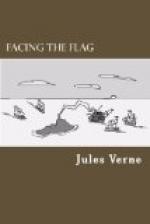Aft, a grizzly-faced man is at the wheel, and he is keeping her head to the sea that is running pretty high.
I try to find out the name of the vessel, but it is not to be seen anywhere, even on the life-buoys.
I walk up to one of the sailors and inquire:
“What is the name of this ship?”
No answer, and I fancy the man does not understand me.
“Where is the captain?” I continue.
But the sailor pays no more heed to this than he did to the previous question.
I turn on my heel and go forward.
Above the forward hatchway a bell is suspended. Maybe the name of the schooner is engraved upon it. I examine it, but can find no name upon it.
I then return to the stern and address the man at the wheel. He gazes at me sourly, shrugs his shoulders, and bending, grasps the spokes of the wheel solidly, and brings the schooner, which had been headed off by a large wave from port, stem on to sea again.
Seeing that nothing is to be got from that quarter, I turn away and look about to see if I can find Thomas Roch, but I do not perceive him anywhere. Is he not on board? He must be. They could have had no reason for carrying me off alone. No one could have had any idea that I was Simon Hart, the engineer, and even had they known it what interest could they have had in me, and what could they expect of me?
Therefore, as Roch is not on deck, I conclude that he is locked in one of the cabins, and trust he has met with better treatment than his ex-guardian.
But what is this—and how on earth could I have failed to notice it before? How is this schooner moving? Her sails are furled—there is not an inch of canvas set—the wind has fallen, and the few puffs that occasionally come from the east are unfavorable, in view of the fact that we are going in that very direction. And yet the schooner speeds through the sea, her bows down, throwing off clouds of foam, and leaving a long, milky, undulating trail in her wake.
Is she a steam-yacht? No—there is not a smokestack about her. Is she propelled by electricity—by a battery of accumulators, or by piles of great power that work her screw and send her along at this rate?
I can come to no other conclusion. In any case she must be fitted with a screw, and by leaning over the stern I shall be able to see it, and can find out what sets it working afterwards.
The man at the wheel watches me ironically as I approach, but makes no effort to prevent me from looking over.
I gaze long and earnestly, but there is no foaming and seething of the water such as is invariably caused by the revolutions of the screw—naught but the long white furrow that a sailing vessel leaves behind is discernible in the schooner’s wake.
Then, what kind of a machine is it that imparts such a marvellous speed to the vessel? As I have already said, the wind is against her, and there is a heavy swell on.




